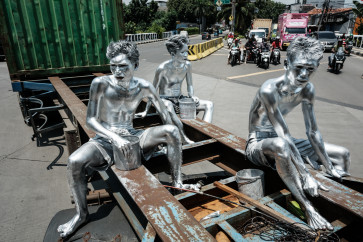Crusader out to protect the past against those plundering it for profits
The damage to hundreds of archaeological sites at Trowulan, the former center of the Majapahit Kingdom, has raised concern among many organizations and individuals
Change text size
Gift Premium Articles
to Anyone

The damage to hundreds of archaeological sites at Trowulan, the former center of the Majapahit Kingdom, has raised concern among many organizations and individuals. One of these is Anam Anis, a lawyer who founded a culture and art appreciation group called Majapahit Gotrah Wilwatikta.
The name Majapahit Gotrah Wilwatikta is taken from the genealogy of Majapahit (trah means having a lineage), while Wilwatikta is another name for Majapahit.
The group has only three members - Anis and his colleagues Saifullah Barnawi and Paidi Jolali - but they are nevertheless being heard in their strong opposition to a massive development project for the Majapahit Information Center. They oppose the project, funded by the budget for Trowulan village in Mojokerto, because the plans are to build on an ancient Majapahit Kingdom site that covers 2,000 square meters.
"For long time we have been hurt by a group of people who have damaged and stolen hundreds of items of value from the archaeological sites of the Majapahit Kingdom," Anis told The Jakarta Post.
Thanks to their passion, their cause is attracting wider attention, with residents of surrounding areas starting to lodge claims and urge the government to relocate the construction.
When it comes to making his point about the damage done to the Majapahit sites, Anis lets the pictures do the talking, showing 16 video recordings and hundreds of photos taken since 2005, which all show people damaging the area and artifacts.
Paidi Jolali, who has a junior high school education and now works in a small shoemaking business in Kedungwali Mojokerto, assembled the collection of videos and photos.
Paidi, while out taking pictures of the looting, was offered a job by an antiques broker to sell statues and bricks from the Majapahit Kingdom. He rejected that opportunity, even though he doesn't receive a penny for his activities in defense of the site; Anis only gives him money for fuel for his motorcycle.
"One of the private television stations in Indonesia even offered a high price for the videos," Anis said. "But Paidi and I rejected that offer; we have given these videos free to all television stations that are interested."
The evidence in the videos is damning. One person is shown prying out heaps of bricks from archaeological sites with a crowbar. The broken bricks were abandoned, while those that were still intact were washed in the river and then sold to a broker for Rp 500 (5 US cents) per brick. Not too bad for the robber: Modern local bricks sell for only Rp 225 each.
But better for the broker. Anis said those bricks were then sold to businesspeople in Bali for a hefty price of Rp 100,000 per brick. The brick trade - effectively selling off the heritage of the Majapahit Kingdom - has been going on since 1980, meaning income for the sellers, and great losses to archaeology.
Looters have also sold off much of the Majapahit Kingdom's treasures, such as jewelry, gold coins and porcelain jugs. Even the statues have not been safe.
Some of the photos Anis shows are of statues found by local residents, which were reported to the Education Coordination Assistance Agency (Badan Pembantu Penyelenggaraan Pendidikan or BP3) and related authorities some months ago. One statue had been placed outside the house of the resident who had reported it missing the next day. Once it went missing, BP3 was not able to record the discovery.
"The residents have become fed up because everyone who reports something to BP3 never hears anything," Anis said. "Consequently the residents have finally stopped caring about the activities of the robbers of the ancient goods from this village."
Anis and his colleagues have not stopped caring. At first, community members and leaders and government officials were not interested in hearing from these three outsiders, but they persisted in their campaign, making people aware of the laws forbidding the sale of historical artifacts.
Finally some residents of Klinterejo village, supported by the village government, formed a Majapahit Kingdom preservation group. They stated that they were ready to take action against all robbers who entered their village to dig up archaeological sites and sell the bricks and other valuable goods.
The group also opposes the plan to build the Majapahit Information Center. They made banners warning of the need to preserve archaeological sites and historical artifacts, and they approached members of the House of Representatives and the regency government, demanding the building be relocated away from the archaeological sites.
So far, the struggle is paying off, with a government response. Tourism and Culture Minister Jero Wacik has halted the development of the project, forecast to cost Rp 3 billion (US$270,000), and has requested its relocation.
But the struggle isn't over yet, Anis said.
"The government hasn't determined its policy, and there are still many villagers who haven't accepted that there is a problem in preserving historical artifacts."









